Environmental Regulation and Industrial Structure Change in China: Integrating Spatial and Social Network Analysis
Abstract
:1. Introduction
2. Background and Data
2.1. Background
2.2. Data
3. Methodology
3.1. Empirical Models
3.2. Specification of Weight Matrix
4. Results
4.1. Network Characters
4.2. Empirical Results
4.2.1. The Results of the Benchmark Model
4.2.2. Spillover Effects and Its Channels
5. Conclusions
Acknowledgments
Author Contributions
Conflicts of Interest
Appendix A

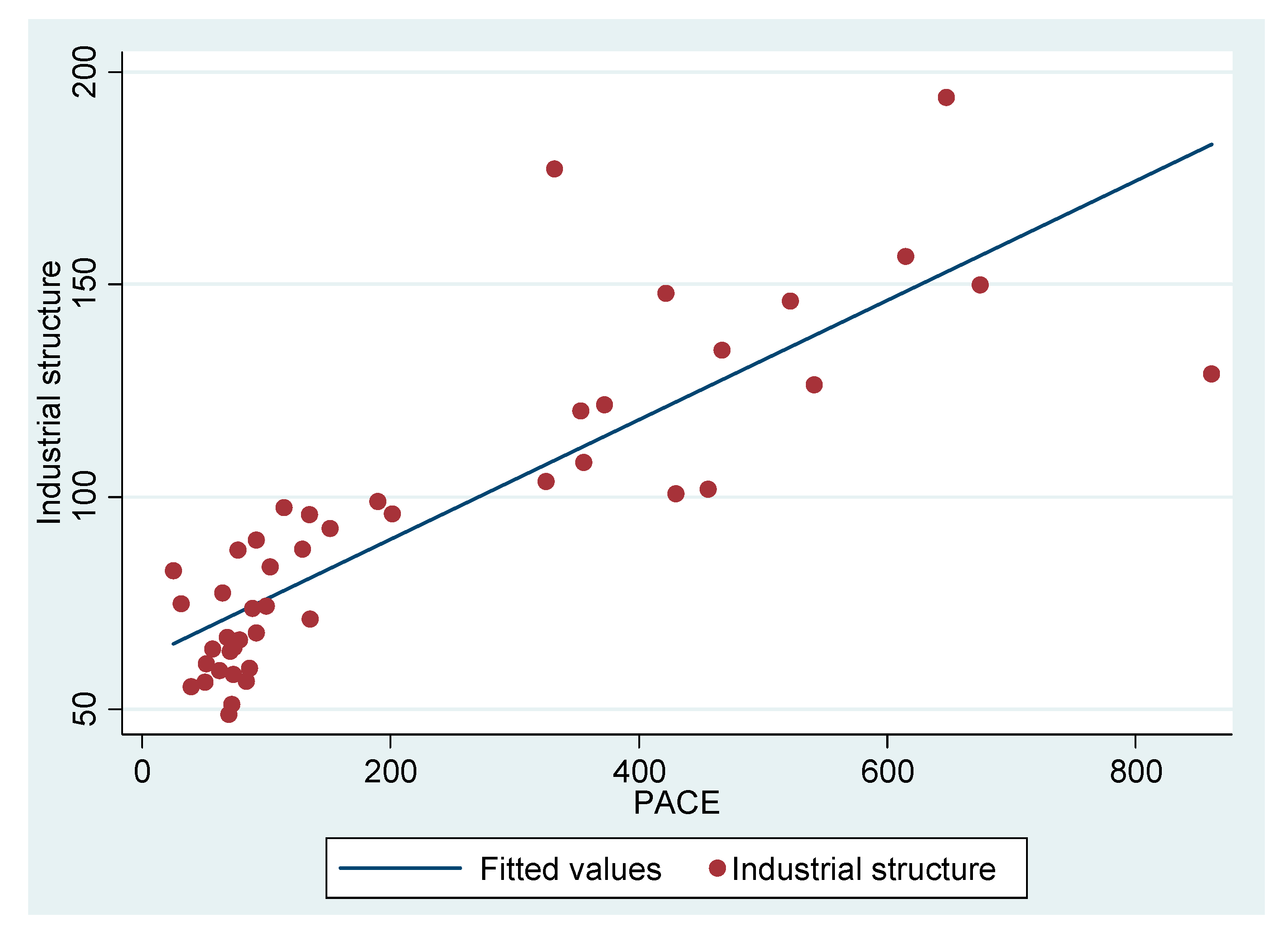

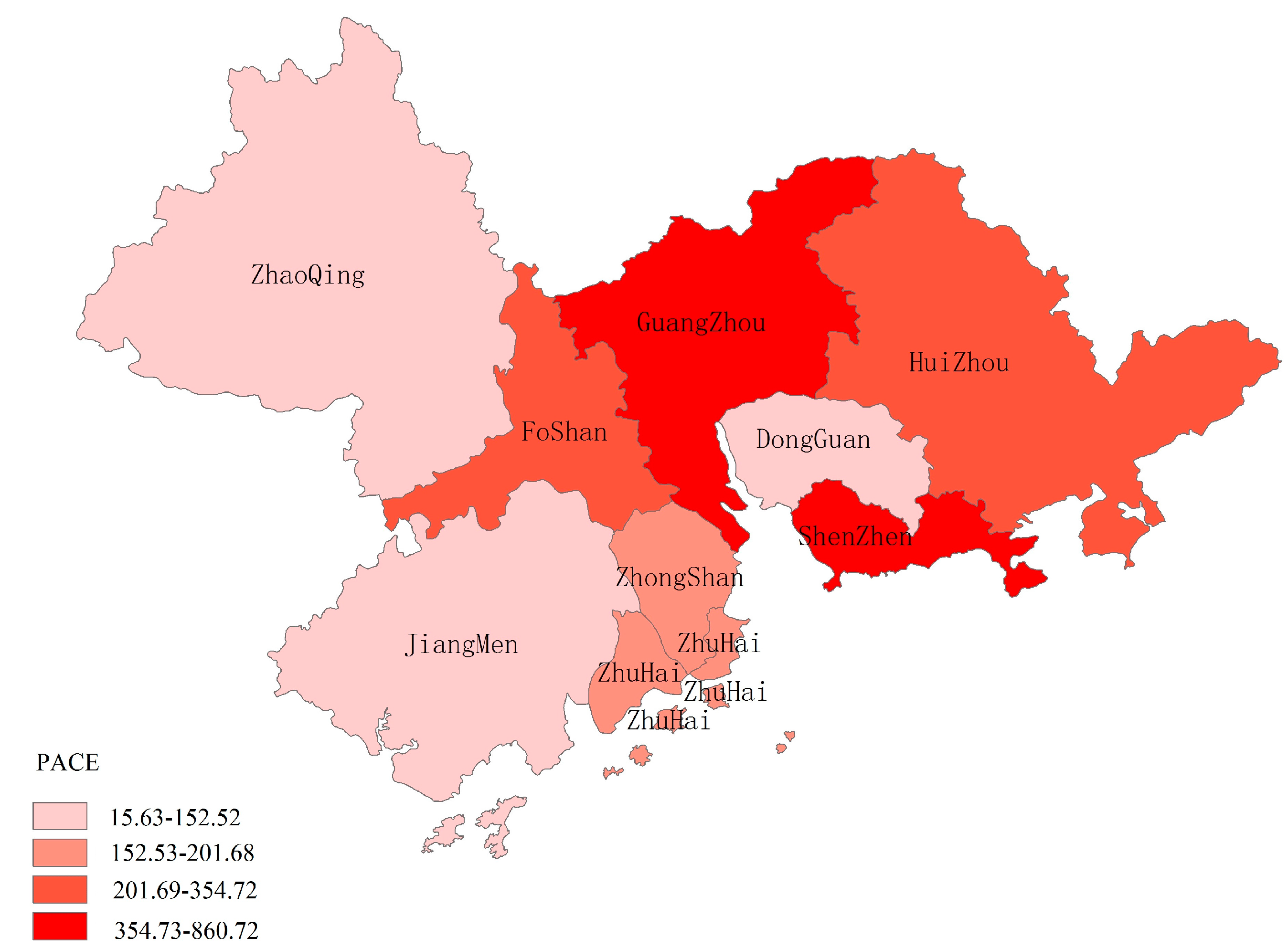
References
- Burton, D.M.; Gomez, I.A.; Love, H.A. Environmental regulation cost and industry structure changes. Land Econ. 2011, 3, 545–557. [Google Scholar] [CrossRef]
- Chong, Z.; Qin, C.; Ye, X. Environmental regulation, economic network and sustainable growth of urban agglomerations in China. Sustainability 2016, 8, 467. [Google Scholar] [CrossRef]
- Levinson, A. Environmental regulations and manufacturers’ location choices: Evidence from the Census of Manufactures. J. Public Econ. 1996, 1, 5–29. [Google Scholar] [CrossRef]
- Li, X.; Ikeda, S. An economic–environmental input–output model and its application to regional economic–environmental impact analysis. Environ. Plan. B 2001, 28, 581–594. [Google Scholar] [CrossRef]
- Wu, Z.; Tang, J.; Wang, D. Low carbon urban transitioning in Shenzhen: A multi-level environmental governance perspective. Sustainability 2016, 8, 720. [Google Scholar] [CrossRef]
- Bushnell, J.B.; Mansur, E.T. Vertical targeting and leakage in carbon policy. Am. Econ. Rev. 2011, 3, 263–267. [Google Scholar] [CrossRef]
- He, C.; Huang, Z.; Ye, X. Spatial heterogeneity of economic development and industrial pollution in urban China. Stoch. Environ. Res. Risk A 2014, 28, 767–781. [Google Scholar] [CrossRef]
- Ryan, S.P. The costs of environmental regulation in a concentrated industry. Econometrica 2012, 3, 1019–1061. [Google Scholar]
- Zhu, J.; Ruth, M. Relocation or reallocation: Impacts of differentiated energy saving regulation on manufacturing industries in china. Ecol. Econ. 2015, 110, 119–133. [Google Scholar] [CrossRef]
- Batten, D.F. Network cities: Creative urban agglomerations for the 21st century. Urban Stud. 1995, 32, 313–327. [Google Scholar] [CrossRef]
- De Goei, B.; Burger, M.J.; van Oort, F.G.; Kitson, M. Functional polycentrism and urban network development in the Greater South East, United Kingdom: Evidence from commuting patterns, 1981–2001. Reg. Stud. 2010, 44, 1149–1170. [Google Scholar] [CrossRef]
- Eagle, N.; Macy, M.; Claxton, R. Network diversity and economic development. Science 2010, 328, 1029–1031. [Google Scholar] [CrossRef] [PubMed]
- Batty, M.; Cheshire, J. Cities as flows. Environ. Plan. B 2011, 38, 195–196. [Google Scholar] [CrossRef]
- Cole, M.A.; Elliott, R.J.; Shimamoto, K. Why the grass is not always greener: The competing effects of environmental regulations and factor intensities on US specialization. Ecol. Econ. 2005, 1, 95–109. [Google Scholar] [CrossRef]
- Huggins, R.; Thompson, P. A Network-based view of regional growth. J. Econ. Geogr. 2014, 14, 511–545. [Google Scholar] [CrossRef]
- Kay, S.; Zhao, B.; Sui, D. Can social media clear the air? A case study of the air pollution problem in Chinese cities. Prof. Geogr. 2015, 67, 351–363. [Google Scholar] [CrossRef]
- Li, Q.; Wei, W.; Xiong, N.; Feng, D.; Ye, X.; Jiang, Y. Social media research, human behavior, and sustainable society. Sustainability 2017, 9, 242. [Google Scholar] [CrossRef]
- Goodchild, M.F. GIS in the Era of Big Data. 2016. Available online: https://cybergeo.revues.org/27647 (accessed on 20 April 2017).
- Ye, X.; Huang, Q.; Li, W. Integrating big social data, computing, and modeling for spatial social science. Cartogr. Geogr. Inf. Sci. 2016. [Google Scholar] [CrossRef]
- Watkins, B.A. Experimenting with dialogue on twitter: An examination of the influence of the dialogic principles on engagement, interaction, and attitude. Public Relat. Rev. 2016, 43, 163–171. [Google Scholar] [CrossRef]
- Batty, M. Smart cities, big data. Environ. Plan. B 2012, 39, 191. [Google Scholar] [CrossRef]
- Gao, S.; Liu, Y.; Wang, Y.; Ma, X. Discovering spatial interaction communities from mobile phone data. T GIS 2013, 17, 463–481. [Google Scholar] [CrossRef]
- Batty, M. Big data, smart cities and city planning. Dialog. Hum. Geogr. 2013, 3, 274–279. [Google Scholar] [CrossRef]
- Ruths, D.; Pfeffer, J. Social media for large studies of behavior. Science 2014, 346, 1063–1064. [Google Scholar] [CrossRef] [PubMed]
- Shaw, S.; Tsou, M.; Ye, X. Human dynamics in the mobile and Big Data Era. Int. J. Geogr. Inf. Sci. 2016, 30, 1687–1693. [Google Scholar] [CrossRef]
- Pijanowski, B.C.; Tayyebi, A.; Doucette, J.; Pekin, B.K.; Braun, D.; Plourde, J. A big data urban growth simulation at a national scale: Configuring the GIS and neural network based land transformation model to run in a high performance computing (HPC) environment. Environ. Model. Softw. 2014, 51, 250–268. [Google Scholar] [CrossRef]
- Artige, L. Will big data deliver its promised productivity growth? In Proceedings of the IAES Conference, Lisbon, Portugal, 16–19 March 2016. [Google Scholar]
- Jarmin, R.S.; O’Hara, A.B. Big data and the transformation of public policy analysis. J. Policy Anal. Manag. 2016, 35, 715–721. [Google Scholar] [CrossRef]
- Wang, Z.; Ye, X.; Tsou, M. Spatial, temporal, and content analysis of Twitter for wildfire hazards. Nat. Hazards 2016, 83, 523–540. [Google Scholar] [CrossRef]
- Dong, L.; Chen, S.; Cheng, Y.; Wu, Z.; Li, C.; Wu, H. Measuring Economic Activities of China with Mobile Big Data. arXiv, 2016; arXiv:1607.04451. [Google Scholar]
- Wei, Y.; Ye, X. Urbanization, Urban Land Expansion and Environmental Change in China. Stoch. Environ. Res. Risk A 2014, 28, 757–765. [Google Scholar] [CrossRef]
- Cheng, J.; Dai, S.; Ye, X. Spatiotemporal heterogeneity of industrial pollution in China. China Econ. Rev. 2016, 40, 179–191. [Google Scholar] [CrossRef]
- Wang, Z.; Ye, X. Reexamining Environmental Kuznets Curve for China’s City-level Carbon Dioxide (CO2) Emissions. Spat. Stat. 2016, in press. [Google Scholar] [CrossRef]
- Li, S.; Ye, X.; Lee, J.; Gong, J.; Qin, C. Spatiotemporal analysis of housing prices in China: A big data perspective. Appl. Spat. Anal. Policy 2017, 10, 421–433. [Google Scholar] [CrossRef]
- Wu, C.; Ye, X.; Ren, F.; Wan, Y.; Ning, P.; Du, Q. Spatial and social media data analytics of housing prices in Shenzhen, China. PLoS ONE 2016, 11, e0164553. [Google Scholar] [CrossRef] [PubMed]
- Ye, X.; He, C. The new data landscape for regional and urban analysis. GeoJournal 2016, 81, 1–5. [Google Scholar] [CrossRef]
- Liu, Y.; Sui, Z.; Kang, C.; Gao, Y. Uncovering patterns of inter-urban trip and spatial interaction from social media check-in data. PLoS ONE 2014, 9, e86026. [Google Scholar] [CrossRef] [PubMed]
- Taylor, P.J. Leading world cities: Empirical evaluations of urban nodes in multiple networks. Urban Stud. 2005, 42, 1593–1608. [Google Scholar] [CrossRef]
- Jin, K. Industrial structure and capital flows. Am. Econ. Rev. 2012, 102, 2111–2146. [Google Scholar] [CrossRef]
- Rubashkina, Y.; Galeotti, M.; Verdolini, E. Environmental regulation and competitiveness: Empirical evidence on the Porter Hypothesis from European manufacturing sectors. Energy Policy 2015, 83, 288–300. [Google Scholar] [CrossRef]
- Organisation for Economic Co-operation and Development (OECD). Pollution Control and Abatement Expenditure in OECD Countries. In Environment Monograph; OECD/GD(96)50; OECD: Paris, France, 1996. [Google Scholar]
- Kheder, S.B.; Zugravu, N. Environmental regulation and French firms location abroad: An economic geography model in an international comparative study. Ecol. Econ. 2012, 77, 48–61. [Google Scholar] [CrossRef]
- Panzar, J.C. Technological determinants of firm and industry structure. Handb. Ind. Organ. 1989, 1, 3–59. [Google Scholar]
- Utterback, J.M.; Suarez, F.F. Innovation, competition, and industry structure. Res. Policy 1993, 22, 1–21. [Google Scholar] [CrossRef]
- Dunne, T.; Klimek, S.D.; Roberts, M.J.; Xu, Y. Entry, exit, and the determinants of market structure. Rand J. Econ. 2013, 44, 462–487. [Google Scholar] [CrossRef]
- Topa, G.; Zenou, Y. Neighborhood versus network effects. In Handbook of Regional and Urban Economics; Duranton, G., Henderson, V., Strange, W., Eds.; Elsevier Publisher: Amsterdam, The Netherlands, 2015; Volume 5. [Google Scholar]
- Halleck, V.S.; Elhorst, J.P. The SLX model. J. Reg. Sci. 2015, 3, 339–363. [Google Scholar] [CrossRef]
- Corrado, L.; Fingleton, B. Where is the economics in spatial econometrics? J. Reg. Sci. 2012, 52, 210–239. [Google Scholar] [CrossRef]
- National Bureau of Statistics of China (NBSC). China City Statistical Yearbook; China Statistics Press: Beijing, China, 2011–2015. (In Chinese) [Google Scholar]
- Anselin, L. Spatial Econometrics: Methods and Models; Springer Science & Business Media: Heidelberg, Germany, 2013; pp. 97–99. [Google Scholar]
- Fagerberg, J.; Verspagen, B.; Caniels, M. Technology, growth and unemployment across European regions. Reg. Stud. 1997, 31, 457–466. [Google Scholar] [CrossRef]
- Wang, Y.; Ning, L.; Li, J.; Prevezer, M. Foreign direct investment spillovers and the geography of innovation in Chinese regions: The role of regional industrial specialization and diversity. Reg. Stud. 2016, 50, 805–822. [Google Scholar] [CrossRef]
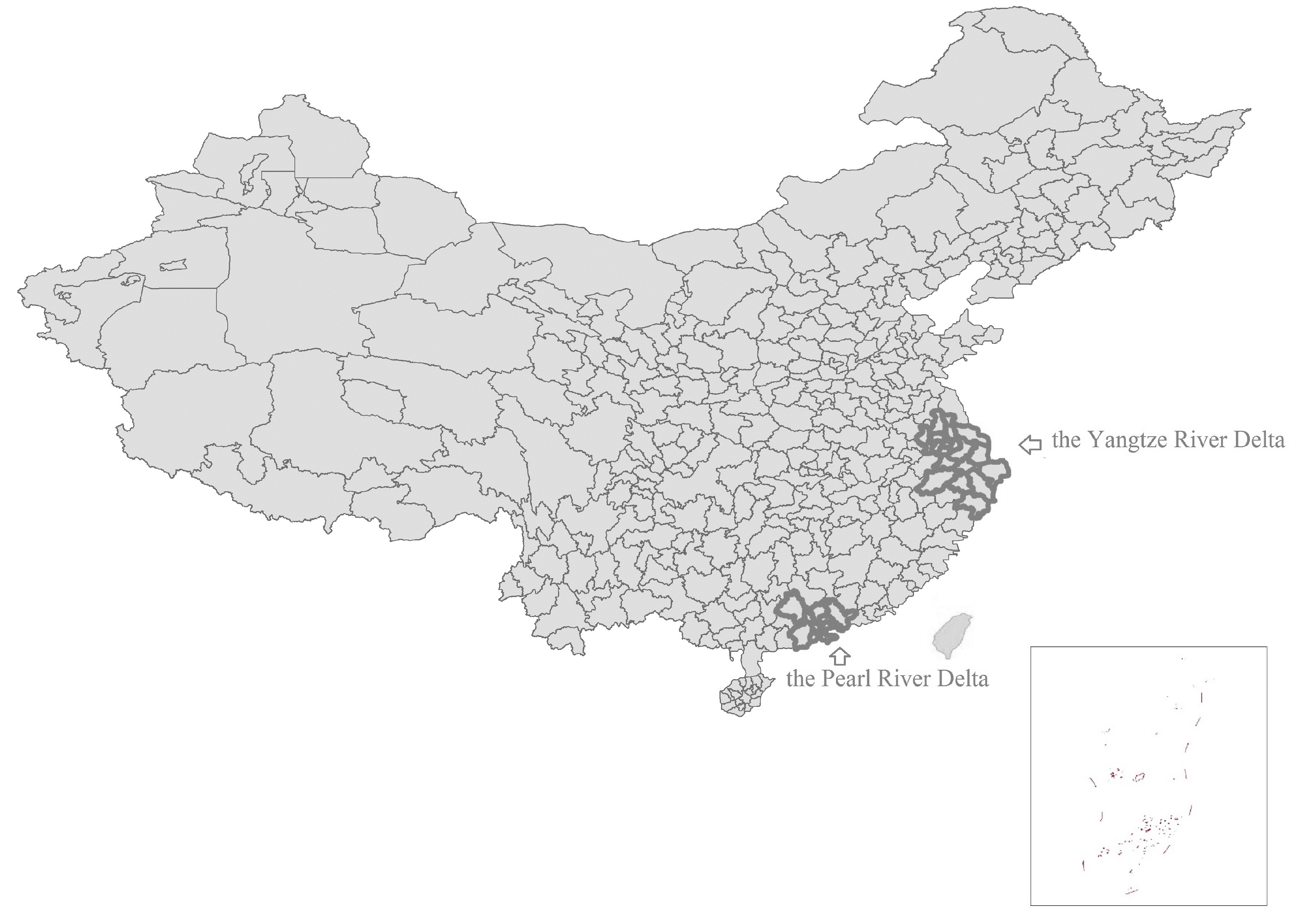



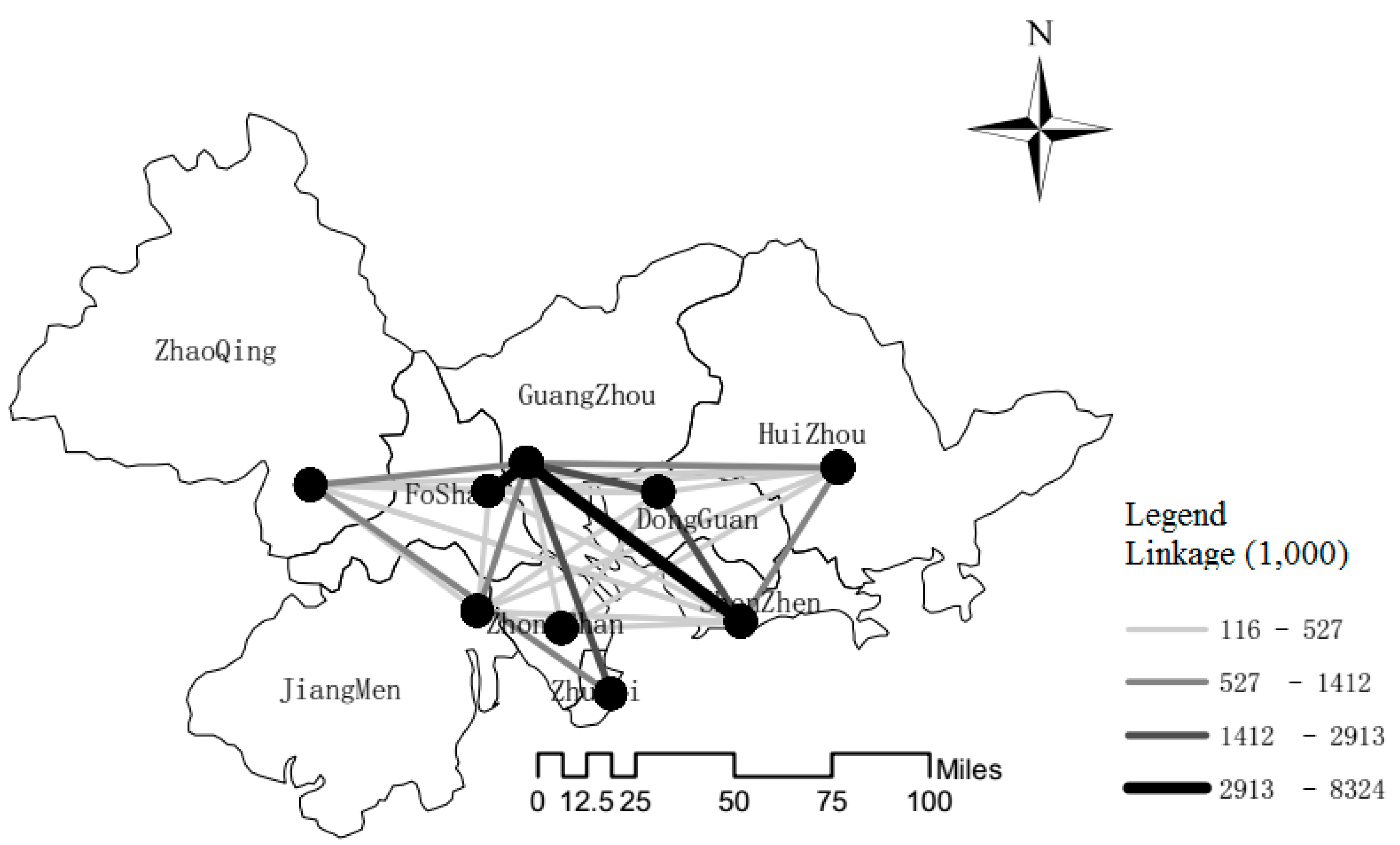
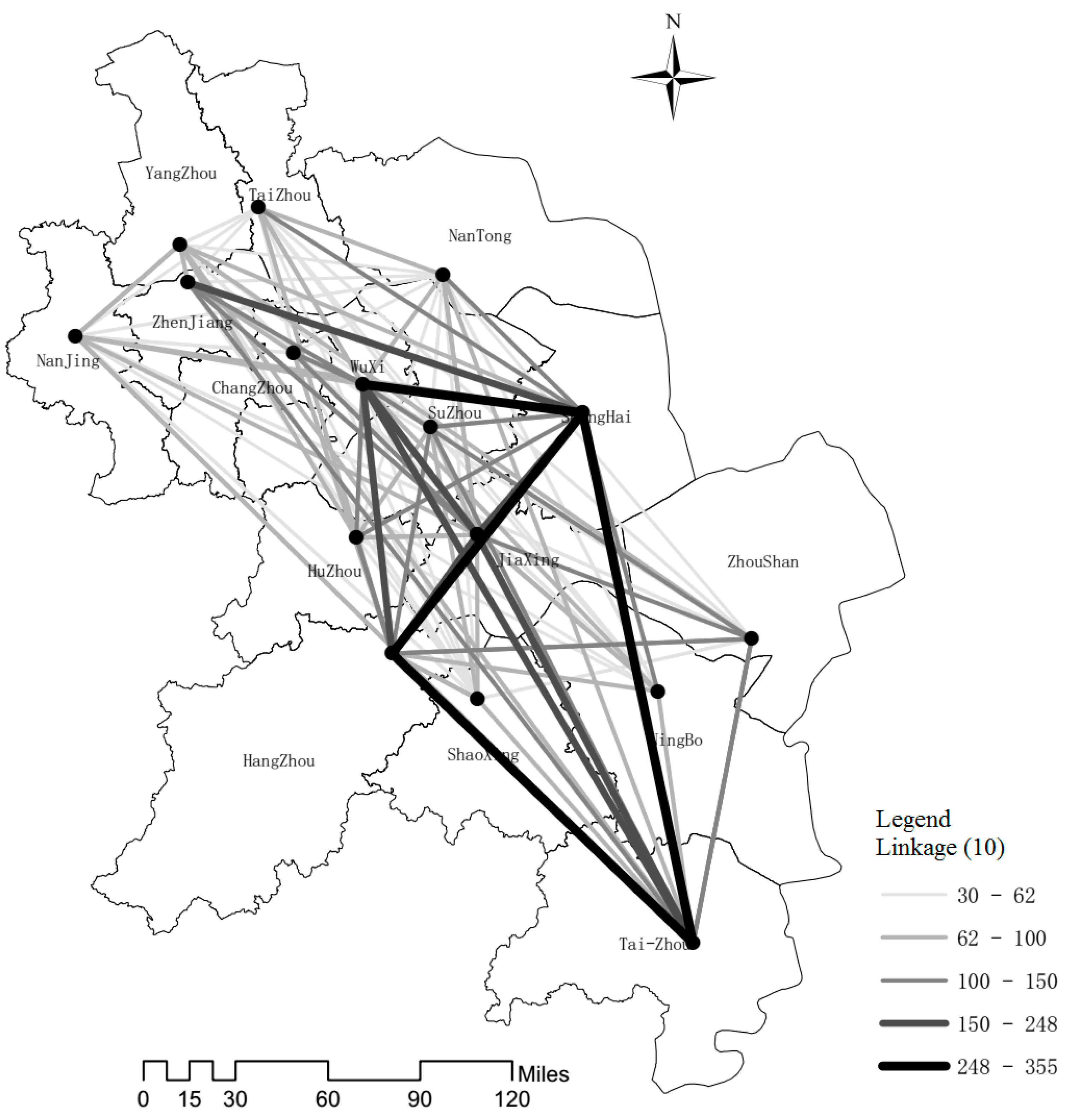

| Variables | (1) | (2) | (3) | (4) | (5) | (6) | (7) |
|---|---|---|---|---|---|---|---|
| Benchmark Model | |||||||
| Environmental regulation | 0.148 *** | 0.152 *** | 0.144 *** | 0.140 *** | 0.137 *** | −0.093 ** | −0.081 * |
| (3.63) | (3.77) | (3.62) | (2.99) | (3.55) | (−2.04) | (−1.81) | |
| Fixed asset investment per capita | 0.173 *** | 0.196 *** | 0.172 ** | 0.107 | 0.142 ** | 0.214 *** | 0.239 *** |
| (3.26) | (4.17) | (2.59) | (1.57) | (2.47) | (3.92) | (3.77) | |
| Wage | 0.129 *** | 0.074 *** | 0.081 * | 0.083 *** | 0.102 ** | −0.073 | −0.082 * |
| (3.99) | (2.88) | (1.72) | (2.87) | (2.52) | (−1.53) | (−1.73) | |
| R&D | 0.107 ** | 0.073 *** | 0.071 *** | 0.102 * | 0.094 | 0.067 | 0.062 |
| (2.55) | (3.02) | (3.52) | (1.82) | (1.35) | (1.32) | (1.05) | |
| GDP per capita | 0.112 *** | 0.124 * | 0.113 ** | 0.137 ** | 0.072 *** | −0.103 * | −0.139 ** |
| (2.94) | (1.75) | (2.61) | (2.56) | (3.29) | (−1.83) | (−2.01) | |
| 3.836 *** | 3.927 *** | 4.011 *** | 3.829 *** | 4.269 *** | 3.723 *** | 3.847 *** | |
| (6.77) | (5.92) | (6.28) | (7.33) | (5.36) | (6.24) | (7.03) | |
| 0.102 *** | 0.094 *** | −0.045 | −0.139 *** | −0.059 * | −0.084 ** | ||
| (4.66) | (3.27) | (−1.07) | (−4.27) | (−1.79) | (−2.13) | ||
| R2 | 0.6728 | 0.7632 | 0.7724 | 0.7263 | 0.6289 | 0.7213 | 0.7139 |
| N. of obs. | 80 | 80 | 80 | 80 | 80 | 80 | 80 |
| Variables | (1) | (2) | (3) | (4) | (5) | (6) | (7) |
|---|---|---|---|---|---|---|---|
| Benchmark Model | |||||||
| Environmental regulation | 0.201 *** | 0.196 *** | 0.182 *** | 0.177 * | 0.193 *** | −0.237 ** | −0.209 * |
| (3.72) | (3.44) | (3.77) | (1.98) | (3.05) | (−2.00) | (−1.84) | |
| Fixed asset investment per capita | 0.134 *** | 0.098 * | 0.084 ** | 0.093 | 0.127 ** | 0.328 *** | 0.309 *** |
| (3.41) | (1.80) | (2.59) | (1.54) | (2.16) | (3.47) | (4.02) | |
| Wage | 0.093 | 0.104 * | 0.106 * | 0.093 ** | 0.131 *** | −0.093 *** | −0.085 ** |
| (1.40) | (1.72) | (1.73) | (2.02) | (2.85) | (−2.74) | (−2.08) | |
| R&D | 0.103 *** | 0.091 *** | 0.113 ** | 0.125 ** | 0.152 * | 0.038 | 0.086 |
| (4.01) | (3.09) | (2.38) | (2.53) | (1.79) | (1.32) | (1.29) | |
| GDP per capita | 0.092 *** | 0.083 ** | 0.042 | 0.093 *** | 0.065 ** | −0.104 | −0.093 * |
| (3.17) | (2.32) | (0.93) | (2.73) | (2.03) | (−1.56) | (−1.82) | |
| 3.727 *** | 3.022 *** | 3.283 *** | 2.938 *** | 2.848 *** | 4.932 *** | 4.730 *** | |
| (4.28) | (3.92) | (3.28) | (3.55) | (3.92) | (3.85) | (3.73) | |
| 0.071 *** | 0.039 ** | −0.083 * | −0.002 *** | −0.085 ** | −0.056 * | ||
| (3.93) | (2.04) | (−1.89) | −(2.82) | (−2.15) | (−1.89) | ||
| R2 | 0.5392 | 0.6163 | 0.6748 | 0.6923 | 0.6225 | 0.7038 | 0.7216 |
| N. of obs. | 45 | 45 | 45 | 45 | 45 | 45 | 45 |
© 2017 by the authors. Licensee MDPI, Basel, Switzerland. This article is an open access article distributed under the terms and conditions of the Creative Commons Attribution (CC BY) license (http://creativecommons.org/licenses/by/4.0/).
Share and Cite
Chong, Z.; Qin, C.; Ye, X. Environmental Regulation and Industrial Structure Change in China: Integrating Spatial and Social Network Analysis. Sustainability 2017, 9, 1465. https://doi.org/10.3390/su9081465
Chong Z, Qin C, Ye X. Environmental Regulation and Industrial Structure Change in China: Integrating Spatial and Social Network Analysis. Sustainability. 2017; 9(8):1465. https://doi.org/10.3390/su9081465
Chicago/Turabian StyleChong, Zhaohui, Chenglin Qin, and Xinyue Ye. 2017. "Environmental Regulation and Industrial Structure Change in China: Integrating Spatial and Social Network Analysis" Sustainability 9, no. 8: 1465. https://doi.org/10.3390/su9081465





